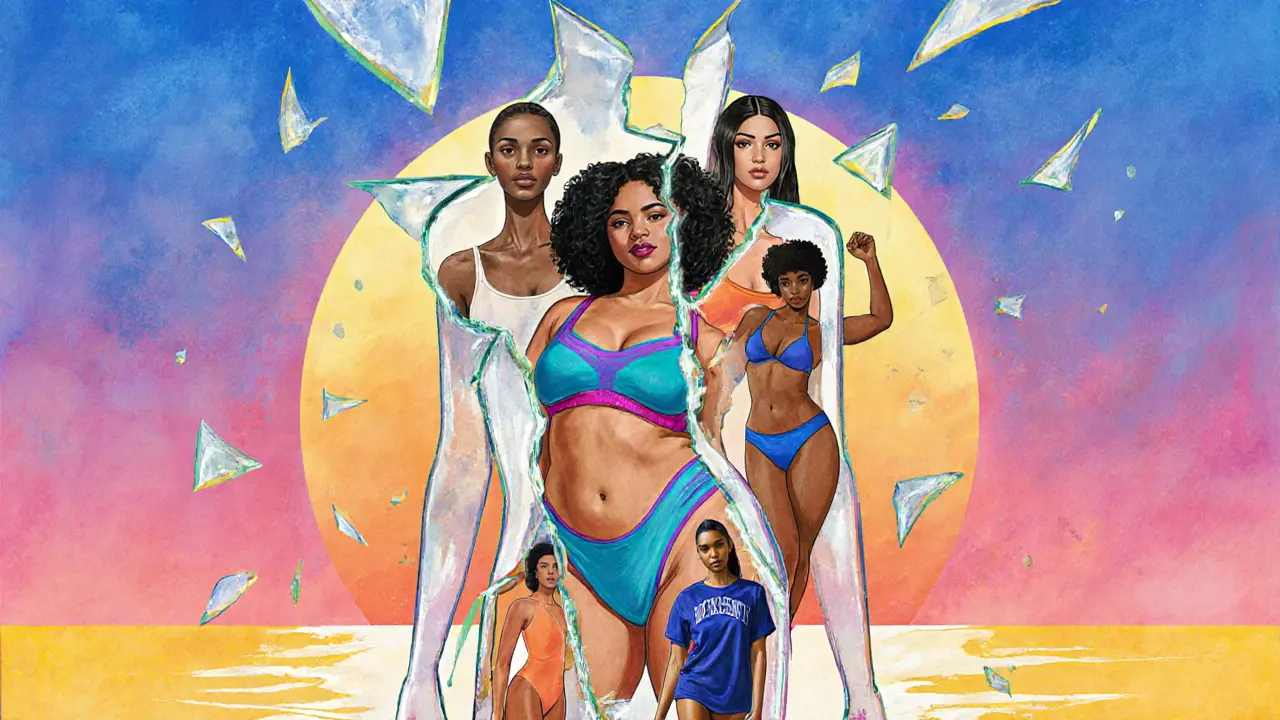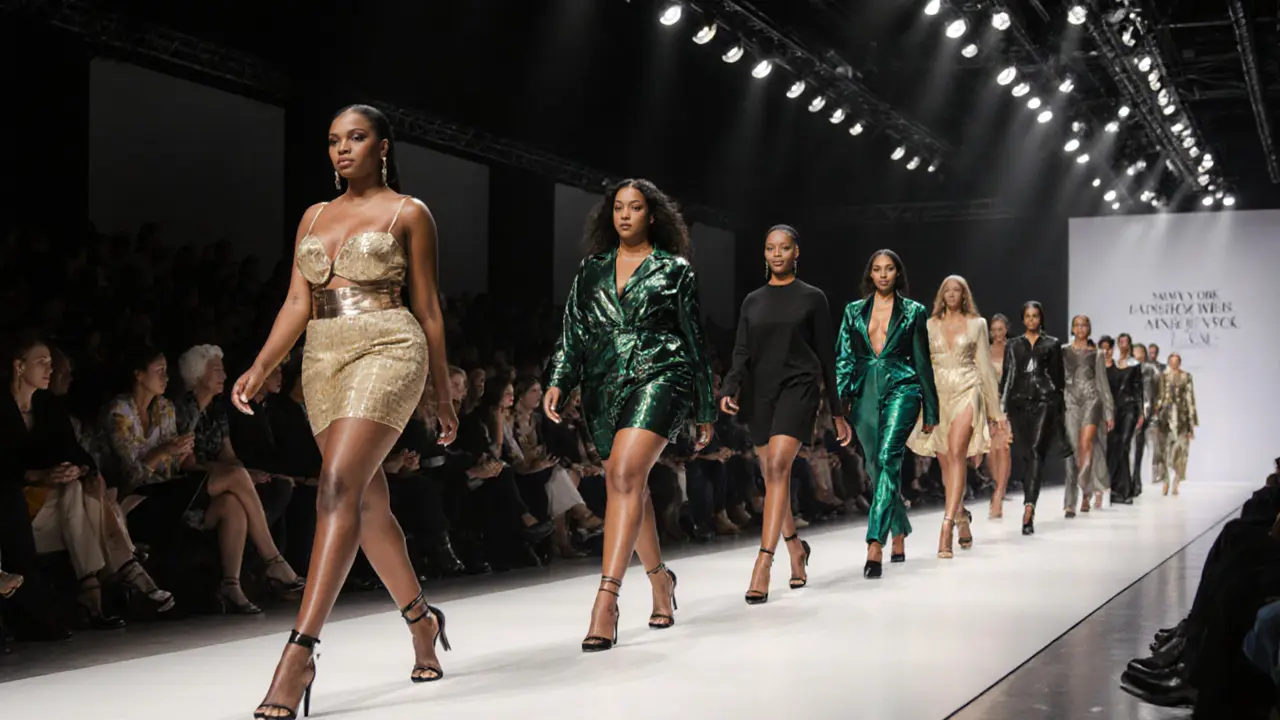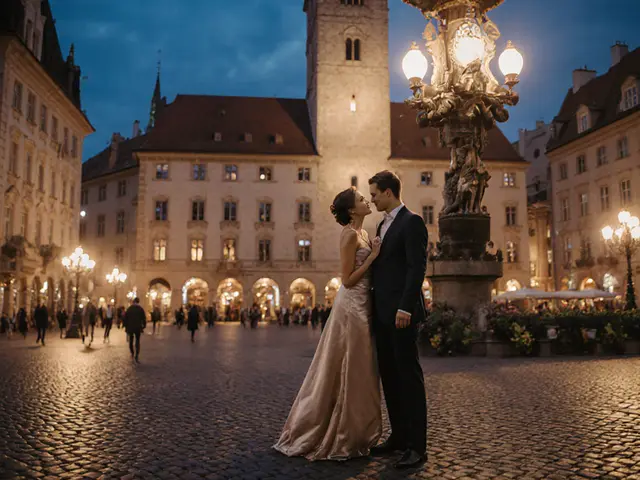You’ve seen them on billboards, in magazine spreads, and scrolling past you on Instagram-curvy models who don’t fit the old-school size zero mold. And they’re not just appearing more often. They’re rewriting the rules of what beauty means in fashion.
What Exactly Is a Curvy Model?
A curvy model isn’t just someone who’s ‘bigger’ than a sample size. She’s typically a size 12 or above, with defined hips, waist, and curves that reflect real human bodies-not airbrushed ideals. Unlike plus-size models who may be styled for comfort or modesty, curvy models are often chosen for their proportion, confidence, and ability to carry high-fashion pieces with the same poise as a straight-size model.
This isn’t just about clothing fitting better. It’s about representation. For decades, fashion ran on one narrow standard: thin, tall, and angular. Curvy models challenge that by proving curves can be elegant, powerful, and marketable. Brands like Savage X Fenty, Lane Bryant’s Cacique, and even mainstream labels like Zara and H&M now regularly feature curvy models in campaigns-not as a token gesture, but as a core part of their identity.
Why This Movement Matters
Think back to your teenage years. Did you ever look in the mirror and feel like your body didn’t belong in the clothes you saw advertised? You weren’t alone. Studies from the University of California show that 80% of women aged 18-34 feel pressure to look like the models in ads. That pressure leads to anxiety, disordered eating, and low self-worth.
Curvy models change that. When you see someone who looks like you-same hips, same thighs, same stretch marks-wearing a stunning red dress on a runway, something shifts. You stop thinking, “I can’t wear that.” and start thinking, “I could.”
It’s not just about self-esteem. It’s about economics. The global plus-size fashion market hit $300 billion in 2024. Brands that ignore curvy customers aren’t just being exclusionary-they’re leaving money on the table. And consumers are voting with their wallets. When Universal Standard launched its 00-40 size range in 2023, sales jumped 217% in six months.
Who Are the Curvy Models Leading the Change?
Some names you’ve probably seen:
- Robyn Lawley-Australian model who walked for Ralph Lauren and Vogue Australia, and was the first plus-size model on the cover of Harper’s Bazaar Australia.
- Paloma Elsesser-A favorite of Chanel and Marc Jacobs, she’s spoken openly about being turned down for jobs because she was “too curvy.” Now she books runways most straight-size models dream of.
- Jasmine Sanders-Signed with IMG, she’s appeared in campaigns for Nike, Fenty Beauty, and Adidas, proving curves belong in sportswear too.
- Iskra Lawrence-Former model turned activist, she built a 3-million-strong following by posting unretouched photos and calling out brands that use digital slimming.
These women didn’t wait for permission. They created their own platforms, pushed back on casting directors, and forced the industry to catch up.

How the Industry Is Changing-Slowly
Back in 2015, only 2% of models on runways were size 12 or above. By 2024, that number jumped to 18%. It’s not perfect. But it’s progress.
Some brands still treat curvy models as a seasonal trend. Others, like ASOS and Nordstrom, have made size inclusivity a permanent policy. ASOS now offers 120+ styles in sizes 16-24 across all product lines. Nordstrom’s “Body Positive” campaign in 2023 featured 47 curvy models across 12 different brands.
Even runway shows are shifting. In 2024, New York Fashion Week featured more curvy models than ever before. Designers like Christian Siriano and Chromat have been leading the charge for years-showing that curves don’t need to be hidden under layers of fabric. They need to be celebrated.
Where You’ll See Curvy Models Today
You don’t need to fly to Milan or Paris to see them. Curvy models are everywhere now:
- Online Retailers: Shein, Revolve, and Boohoo all feature curvy models in their lookbooks.
- Department Stores: Macy’s, Kohl’s, and Target now have dedicated plus-size sections with real-body imagery.
- Social Media: Instagram and TikTok are full of curvy influencers who partner with brands directly, bypassing traditional modeling agencies.
- Advertising: From Dove’s “Real Beauty” campaigns to Nike’s “You Can’t Stop Us,” curvy bodies are no longer an exception-they’re the norm.
Even fast fashion, once criticized for excluding larger bodies, is now racing to catch up. Why? Because customers demanded it. And they’re not going back.
What to Expect If You Want to Become a Curvy Model
If you’re thinking about stepping into the industry, here’s the truth:
- You don’t need to be a certain height. Many curvy models are 5’5” or shorter.
- Portfolio matters more than agency connections. Shoot with local photographers who specialize in body-positive styling.
- Don’t wait for permission. Post your photos. Tag brands you love. Build your own audience.
- Be ready for backlash. Some people will say you’re “promoting obesity.” Ignore them. This isn’t about health-it’s about dignity.
Agencies like Wilhelmina Models and Next Management now have dedicated curvy divisions. But the best path? Start small. Apply to local boutiques, collaborate with indie designers, and build a reel that shows your personality-not just your body.

Curvy Models vs. Traditional Models: A Real Comparison
| Aspect | Curvy Models | Traditional Models |
|---|---|---|
| Typical Size Range | Size 12-24 | Size 0-8 |
| Body Shape | Defined curves, fuller hips and bust | Slim, linear silhouette |
| Market Reach | 80% of women in the U.S. fall into this size range | Represents less than 5% of the population |
| Brand Partnerships | Focused on inclusivity, lifestyle, and confidence | High fashion, luxury, editorial |
| Media Representation | Rising rapidly since 2020 | Declining as audiences demand diversity |
| Client Demand | 89% of consumers say they prefer seeing diverse body types | Only 12% of shoppers feel represented by traditional models |
Frequently Asked Questions
Are curvy models only for plus-size clothing?
No. Curvy models wear everything-from high-end couture to activewear to swimwear. Brands like Athleta, Aerie, and even Gucci now feature curvy models in their mainline collections, not just in “plus-size” sections. It’s about showing that curves look good in all kinds of clothing.
Do curvy models have to be healthy?
The conversation around health is often misused to police bodies. Curvy models are chosen for their appearance, confidence, and professionalism-not their BMI or diet. Health isn’t visible on the outside, and no brand should use it as a gatekeeping tool. The goal is to normalize all bodies, not to redefine what’s “acceptable.”
Why do some people say curvy models are ‘unrealistic’?
That’s usually coming from people who still believe beauty has one shape. But curvy models aren’t trying to be “ideal”-they’re trying to be real. The average American woman is a size 16. If fashion wants to speak to real customers, it needs to show real bodies. That’s not unrealistic. That’s reality.
Is the curvy model movement just a trend?
Trends fade. This movement is growing because it’s rooted in demand. Consumers aren’t just asking for diversity-they’re refusing to buy from brands that don’t include it. Social media has given power back to the people. This isn’t a trend. It’s a permanent shift.
Can men be curvy models too?
Absolutely. While the term “curvy model” is often used for women, men with fuller builds are also breaking into fashion. Brands like Tommy Hilfiger and H&M have featured male models with broader builds in their campaigns. The same principles apply: representation, confidence, and authenticity matter more than a number on a scale.
What’s Next?
The next frontier? Curvy models in editorial fashion magazines like Vogue and Harper’s Bazaar-not just in spreads labeled “Curves,” but as the lead face of the issue. That’s already happening. In 2024, Vogue Italia featured a curvy model on its cover for the first time in 30 years.
Change doesn’t happen overnight. But every time a brand hires a curvy model, every time a teenager sees herself in an ad, every time a little girl says, “I can be that,” the mold cracks a little more.
You don’t need to be a model to be part of this. Just support the brands that include all bodies. Share the photos that show real skin, real stretch marks, real confidence. Demand better. And never let anyone tell you your body doesn’t belong in fashion-because it always has.






Beverly DeSimone
I remember seeing my first curvy model on a billboard when I was 16. I didn’t cry-I just stared. For the first time, I didn’t feel like I had to shrink myself to fit in. That moment didn’t fix everything, but it started something.
Now I buy from brands that show real bodies. Not because it’s trendy, but because I refuse to support companies that make girls like me feel broken.
Thank you for writing this. It’s not just fashion. It’s freedom.
Kathy Irion
I must say, this article is profoundly well-researched and thoughtfully articulated. The inclusion of statistical data alongside personal narratives elevates the discourse beyond mere aesthetics.
It is imperative that we recognize this movement not as a passing fad, but as a necessary correction to decades of systemic exclusion. The economic argument alone-$300 billion market-is irrefutable.
Still, I worry about performative allyship. Some brands still place curvy models in the ‘plus-size’ section, as if their bodies are a separate category. True inclusion means no subsections. Just fashion. Period.
Danny van Adrichem
Okay but let’s be real-this isn’t about ‘body positivity.’ It’s a Marxist plot to destroy traditional beauty standards and replace them with state-approved body types.
Look at the data: 89% of consumers ‘prefer diverse body types’? Who polled them? TikTok teens with 3 followers and a filter? The FDA hasn’t even approved ‘curvy’ as a medical classification.
And why are we letting women who eat McDonald’s every day be on billboards? What’s next? Letting obese people model swimwear? 😤
They’re not celebrating bodies-they’re normalizing disease. And don’t even get me started on how this is destroying the modeling industry. 🤡
Nishad Ravikant
From India, I want to say this: we have always celebrated curves. Think of classical dance, traditional saree drapes, even our goddesses-full hips, round bellies, strong shoulders. This isn’t a Western invention. It’s a return.
But here, brands still push skinny models because they think ‘global’ means ‘white and thin.’ I’ve seen local designers get ignored for using curvy models-even though their customers are size 14 and up.
Change is slow, but it’s coming. We just need more voices like yours to push it forward.
S.l F
It is with great respect and admiration that I acknowledge the transformative impact of this movement. The fashion industry, long dominated by homogeneity, is now being held accountable by the very consumers it sought to exclude.
One cannot underestimate the psychological liberation afforded to young girls who see themselves reflected in media. This is not merely a commercial shift-it is a moral imperative.
I commend the models who have persisted despite systemic barriers. Their courage is a beacon for all who have ever been told their bodies were unworthy.
May this progress continue with integrity and without co-optation by corporations seeking only profit.
Michael Allerby
Bro. This isn’t just fashion. This is revolution in a sequin dress.
I used to think ‘curvy’ meant ‘plus-size’-turns out it’s about having actual curves, not just extra weight. Like, Paloma Elsesser? She’s got the hips of a goddess and the confidence of a CEO. She walked for Chanel like she owned the damn runway.
And the best part? You don’t need a 6-figure agency deal to be part of this. Just post a pic in your favorite jeans. Tag a brand. Watch them scramble to reply.
My 12-year-old cousin now wears crop tops. No shame. No filters. Just her. That’s the win.
Also, if someone says ‘obesity’ in this thread, I’m gonna throw my coffee at them. 💥
Devin Tankersley
Look, I get it. You want to feel good about yourself. But this whole ‘curvy model’ thing is just another way for fat people to gaslight society into thinking their health doesn’t matter.
They’re not ‘celebrating diversity’-they’re celebrating denial. Every time a brand puts a size 20 on a runway, they’re telling kids it’s okay to be unhealthy.
And don’t even get me started on the lies. ‘Average American woman is size 16’? That’s not average-that’s a crisis. CDC data says 74% of adults are overweight or obese. This isn’t representation. It’s a public health disaster wrapped in a Lululemon hoodie.
Someone needs to tell these girls they’re being manipulated. Not empowered.
Mathew Thomas
They didn’t ask for permission.
And that’s the whole point.